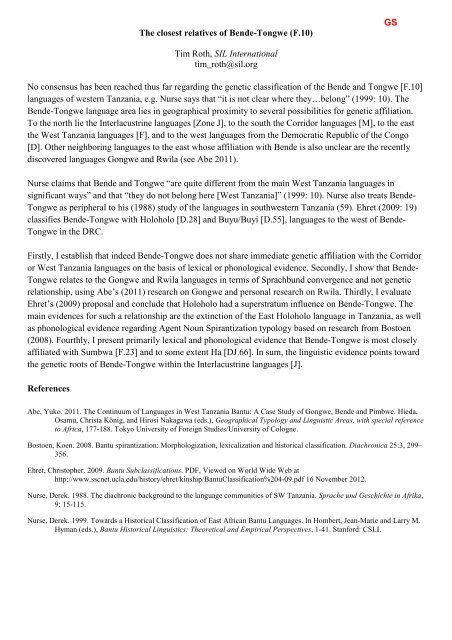here - 5th International Conference on Bantu Languages
here - 5th International Conference on Bantu Languages
here - 5th International Conference on Bantu Languages
Create successful ePaper yourself
Turn your PDF publications into a flip-book with our unique Google optimized e-Paper software.
The closest relatives of Bende-T<strong>on</strong>gwe (F.10)<br />
Tim Roth, SIL <str<strong>on</strong>g>Internati<strong>on</strong>al</str<strong>on</strong>g><br />
tim_roth@sil.org<br />
No c<strong>on</strong>sensus has been reached thus far regarding the genetic classificati<strong>on</strong> of the Bende and T<strong>on</strong>gwe [F.10]<br />
languages of western Tanzania, e.g. Nurse says that “it is not clear w<str<strong>on</strong>g>here</str<strong>on</strong>g> they…bel<strong>on</strong>g” (1999: 10). The<br />
Bende-T<strong>on</strong>gwe language area lies in geographical proximity to several possibilities for genetic affiliati<strong>on</strong>.<br />
To the north lie the Interlacustrine languages [Z<strong>on</strong>e J], to the south the Corridor languages [M], to the east<br />
the West Tanzania languages [F], and to the west languages from the Democratic Republic of the C<strong>on</strong>go<br />
[D]. Other neighboring languages to the east whose affiliati<strong>on</strong> with Bende is also unclear are the recently<br />
discovered languages G<strong>on</strong>gwe and Rwila (see Abe 2011).<br />
Nurse claims that Bende and T<strong>on</strong>gwe “are quite different from the main West Tanzania languages in<br />
significant ways” and that “they do not bel<strong>on</strong>g <str<strong>on</strong>g>here</str<strong>on</strong>g> [West Tanzania]” (1999: 10). Nurse also treats Bende-<br />
T<strong>on</strong>gwe as peripheral to his (1988) study of the languages in southwestern Tanzania (59). Ehret (2009: 19)<br />
classifies Bende-T<strong>on</strong>gwe with Holoholo [D.28] and Buyu/Buyi [D.55], languages to the west of Bende-<br />
T<strong>on</strong>gwe in the DRC.<br />
Firstly, I establish that indeed Bende-T<strong>on</strong>gwe does not share immediate genetic affiliati<strong>on</strong> with the Corridor<br />
or West Tanzania languages <strong>on</strong> the basis of lexical or ph<strong>on</strong>ological evidence. Sec<strong>on</strong>dly, I show that Bende-<br />
T<strong>on</strong>gwe relates to the G<strong>on</strong>gwe and Rwila languages in terms of Sprachbund c<strong>on</strong>vergence and not genetic<br />
relati<strong>on</strong>ship, using Abe’s (2011) research <strong>on</strong> G<strong>on</strong>gwe and pers<strong>on</strong>al research <strong>on</strong> Rwila. Thirdly, I evaluate<br />
Ehret’s (2009) proposal and c<strong>on</strong>clude that Holoholo had a superstratum influence <strong>on</strong> Bende-T<strong>on</strong>gwe. The<br />
main evidences for such a relati<strong>on</strong>ship are the extincti<strong>on</strong> of the East Holoholo language in Tanzania, as well<br />
as ph<strong>on</strong>ological evidence regarding Agent Noun Spirantizati<strong>on</strong> typology based <strong>on</strong> research from Bostoen<br />
(2008). Fourthly, I present primarily lexical and ph<strong>on</strong>ological evidence that Bende-T<strong>on</strong>gwe is most closely<br />
affiliated with Sumbwa [F.23] and to some extent Ha [DJ.66]. In sum, the linguistic evidence points toward<br />
the genetic roots of Bende-T<strong>on</strong>gwe within the Interlacustrine languages [J].<br />
References<br />
Abe, Yuko. 2011. The C<strong>on</strong>tinuum of <strong>Languages</strong> in West Tanzania <strong>Bantu</strong>: A Case Study of G<strong>on</strong>gwe, Bende and Pimbwe. Hieda,<br />
Osamu, Christa König, and Hirosi Nakagawa (eds.), Geographical Typology and Linguistic Areas, with special reference<br />
to Africa, 177-188. Tokyo University of Foreign Studies/University of Cologne.<br />
Bostoen, Koen. 2008. <strong>Bantu</strong> spirantizati<strong>on</strong>: Morphologizati<strong>on</strong>, lexicalizati<strong>on</strong> and historical classificati<strong>on</strong>. Diachr<strong>on</strong>ica 25:3, 299–<br />
356.<br />
Ehret, Christopher. 2009. <strong>Bantu</strong> Subclassificati<strong>on</strong>s. PDF, Viewed <strong>on</strong> World Wide Web at<br />
http://www.sscnet.ucla.edu/history/ehret/kinship/<strong>Bantu</strong>Classificati<strong>on</strong>%204-09.pdf 16 November 2012.<br />
Nurse, Derek. 1988. The diachr<strong>on</strong>ic background to the language communities of SW Tanzania. Sprache und Geschichte in Afrika,<br />
9: 15-115.<br />
Nurse, Derek. 1999. Towards a Historical Classificati<strong>on</strong> of East African <strong>Bantu</strong> <strong>Languages</strong>. In Hombert, Jean-Marie and Larry M.<br />
Hyman (eds.), <strong>Bantu</strong> Historical Linguistics: Theoretical and Empirical Perspectives, 1-41. Stanford: CSLI.<br />
GS


